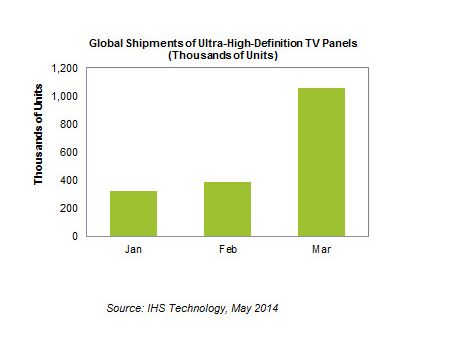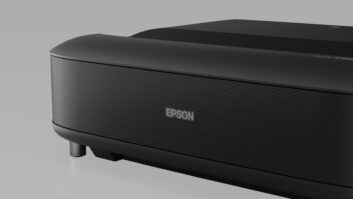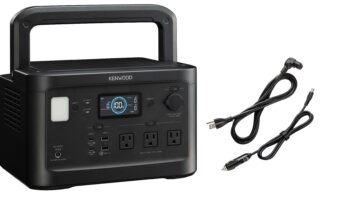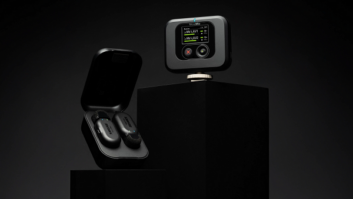
El Segundo, Calif. — Global shipments of Ultra HD TV LCD panels exceeded 1 million units for the first time in March, according to new research issued by IHS Technology.
The market research firm said the volumes were driven by “vastly increased deliveries from the industry’s three largest makers of the high-end panels,
Ultra HD TV panel shipments amounted to 1.1 million units in March, nearly a three-fold increase from 384,300 units a month earlier in February.
In March 2013, Ultra HD panel volumes amounted to just 150,000 units.
“From the time UHD TV panels were introduced to the world for the first time in 2012, demand for these cutting-edge displays has been slow in growing, mainly because the televisions using the panels have proved prohibitively expensive,” stated Linda Lin, IHS large displays senior analyst. “But with the technology becoming more pervasive, coupled with increasingly aggressive marketing from panel manufacturers, UHD TV panels are starting to take off.”
The firm attributed the growth to Ultra HD pre-stocking orders for China’s Labor Day holiday at the beginning of May, and the FIFA World Cup in June.
Underscoring the surge was the fact that four of the market’s six panel makers enjoyed shipment growth rates last month exceeding 100 percent compared with February levels.
According to the “LCD Shipment Database April 2014” report of the world’s six top Ultra HD TV panel makers, Taiwan’s Innolux led the market in March, with shipments of 50-inch panels amounting to approximately 210,000 units, for 47 percent of the firm’s total Ultra HD TV panel deliveries.
Samsung Display of South Korea was second, with 55-inch panels climbing 160 percent for the month. The company also mass-produced new 40- and 48-inch Ultra HD TV panels for the first time.
LG Display was third, offering 395 percent month-to-month growth. It shipped new 42-inch Ultra HD panels for the first time while also doubling shipments in 49-, 55- and 65-inch panels.
IHS said the South Korean panel makers are beginning to launch lower-cost Ultra HD TV displays, including the so-called “Green” panels from Samsung and G+ panels LG.
The Green panel allows the reduction of Ultra HD panel manufacturing costs by using fewer display driver integrated circuits and a different pixel pattern with only three-quarters of true 3,180 by 2,160 Ultra HD resolution,
Other top global Ultra HD TV panel makers include AUO of Taiwan in fourth place, China’s CSOT in fifth, and Japan’s Sharp in sixth.
The top four makers each had monthly shipment growth rates surpassing 100 percent, while AUO and CSOT each saw shipments in March rise by more than 50 percent, IHS said.
Lower-cost panels from Samsung and LG are expected to be a major driving force in expansion this year, IHS said.
By year-end, Ultra HD shipments are forecast to reach 15.2 million units, up from 3.1 million in 2013 and accounting for 6 percent of the total LCD TV panel market this year.
Panels 60 inches or larger will be the key performers, taking an estimated 27 percent of the total Ultra HD panel space.
IHS said the strongest demand for Ultra HD TVs comes from the China, where the advantages presented by Ultra HD resolution play well to consumers.
Having already adopted 3D technology and the smart-TV concept — both of which are better realized on Ultra HD panels — the Chinese market understands the benefits of Ultra HD TV panels, according to Kacie Cavanaugh, IHS large displays analyst.
Shipments of Ultra HD panels are forecast to increase at a faster rate than the total TV panel market. Demand for Ultra HD panels will grow to 68.4 million units by 2018, up 350 percent from 2014, IHS predicts. In comparison, TV panel shipments in general will rise just 12 percent.
Two major obstacles to Ultra HD technology success are the high price of both the panel and the end unit, and the lack of readily available content.
The lack of higher-resolution content continues to be a problem for Ultra HD because no broadcast programming is available so far. However, IHS said streaming Ultra HD content has become available in the U.S., is planned for other regions, and some set manufacturers are offering Ultra HD film titles with their Ultra HD media players.
“Even if the up-scaled material does not match the level of a true UHD screen, the picture is still of higher quality than what FullHD can deliver,” IHS said.














